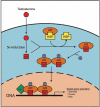Overcoming drug resistance and treating advanced prostate cancer
- PMID: 22746994
- PMCID: PMC3474961
- DOI: 10.2174/138945012802429615
Overcoming drug resistance and treating advanced prostate cancer
Abstract
Most of the prostate cancers (PCa) in advanced stage will progress to castration-resistant prostate cancer (CRPC). Within CRPC group, 50-70% of the patients will develop bone metastasis in axial and other regions of the skeleton. Once PCa cells spread to the bone, currently, no treatment regimens are available to eradicate the metastasis, and cancer-related death becomes inevitable. In 2012, it is estimated that there will be 28,170 PCa deaths in the United States. Thus, PCa bone metastasis-associated clinical complications and treatment resistance pose major clinical challenges. In this review, we will present recent findings on the molecular and cellular pathways that are responsible for bone metastasis of PCa. We will address several novel mechanisms with a focus on the role of bone and bone marrow microenvironment in promoting PCa metastasis, and will further discuss why prostate cancer cells preferentially metastasize to the bone. Additionally, we will discuss novel roles of several key pathways, including angiogenesis and extracellular matrix remodeling in bone marrow and stem cell niches with their relationship to PCa bone metastasis and poor treatment response. We will evaluate how various chemotherapeutic drugs and radiation therapies may allow aggressive PCa cells to gain advantageous mutations leading to increased survival and rendering the cancer cells to become resistant to treatment. The novel concept relating several key survival and invasion signaling pathways to stem cell niches and treatment resistance will be reviewed. Lastly, we will provide an update of several recently developed novel drug candidates that target metastatic cancer microenvironments or niches, and discuss the advantages and significance provided by such therapeutic approaches in pursuit of overcoming drug resistance and treating advanced PCa.
Figures



References
-
- Huggins C, Hodges CV. Studies on prostatic cancer. I. The effect of castration, of estrogen and of androgen injection on serum phosphatases in metastatic carcinoma of the prostate. 1941. J Urol. 2002;167(2 Pt 2):948–51. discussion 52. - PubMed
-
- Huggins C. The Hormone-Dependent Cancers. JAMA. 1963;186:481–3. - PubMed
-
- GLOBOCAN v1.2. Cancer Incidence and Mortality Worldwide: IARC CancerBase No. 10. 2008.
-
- Siegel R, Ward E, Brawley O, Jemal A. Cancer statistics, 2011: the impact of eliminating socioeconomic and racial disparities on premature cancer deaths. CA Cancer J Clin. 2011;61(4):212–36. - PubMed
-
- Siegel R, Naishadham D, Jemal A. Cancer statistics, 2012. CA Cancer J Clin. 2012;62(1):10–29. - PubMed
Publication types
MeSH terms
Substances
LinkOut - more resources
Full Text Sources
Other Literature Sources
Medical
